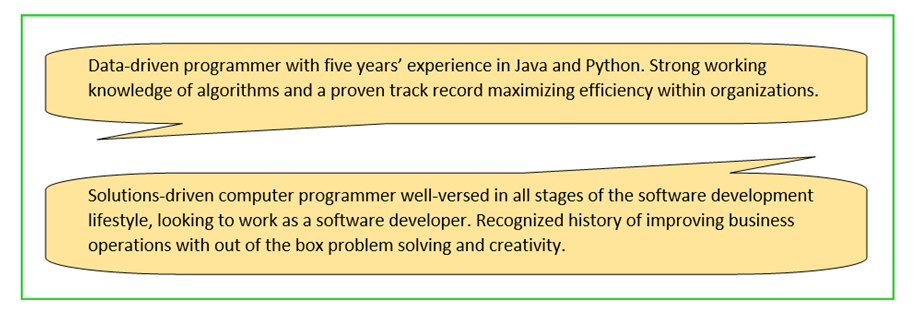So, you want to get into tech? In the current technological revolution, your skills could land you a job right in the center of things. Many recruiters are looking for programmers; however, it’s a competitive market and the hiring process is ever-evolving.
How will you get your foot in the door and stand out from other candidates? An impressive, polished programming resume could be your ticket to success.
Sitting down to write a resume can feel daunting. After all, many potential employers will only give it a few moments of their attention. So a good first impression is everything.
If you’re passionate about programming, you’ll know that coding is all about solving problems. Whether it’s developing a phone system online, an app to manage your to-do lists better, or optimising data handling, it’s all about breaking a task down into its logical components.
You’ll be relieved to know, then, that writing a programming resume is not an art: it’s a science. This article will guide you through each step in creating a programming resume, what to include, and how to highlight your skills.
RELATED: Should You Lie on Your Resume?
Before you get started
- Review the job description for keywords
When you read through a job description, take note of qualifications, skills, and personality traits the recruiter is looking for in an ideal candidate. A good programming resume will not be a generic document about who you are but rather a targeted look at why you’re the best person for the job.
Recruiters are also likely to use an automated system to filter through applicants. Including the keywords will flag your resume as worthy of attention. Impress the automated system and then you can go on to impress a human recruiter.
Don’t be daunted if you don’t understand everything in the job description. For example, don’t be put off from applying for an ecommerce company because you don’t yet know the differences between CRM and CMS – this is the type of thing you can learn on the job!
- Keep length in mind
Ideally, your resume should take up a maximum of two sides of an A4 paper. A single, well structured page is more impressive than a lengthy document bogged down with unnecessary details.
Knowing from the start that you’re writing a short document will help you avoid waffling and wasting time on words that need to be cut.
Similarly, don’t be afraid to use plain language – keep it simple and readable!
- Pick a sensible font
Your font choice should be legible and easy to scan through. Stick to size 12 and opt for a classic font like Times New Roman or Arial. Sans-serif fonts like Helvetica are also safe options – it’s all about minimalism and simplicity. Remember, this could be quite a dense document.
Sections to include in your programming resume
Name and contact info
This one is pretty self-explanatory. If you’re struggling to get started, the template below will help you push past the unnerving blank page.
[Full name]
[Contact Number]
[Email Address]
[City, State]
[Link to portfolio or LinkedIn profile]
Including your physical location is optional, but it can be helpful if the job specifies an area of preference. You can also leave out your LinkedIn profile if you prefer, but it doesn’t hurt to give recruiters a way to look you up if they are interested, especially if your online presence is particularly impressive.
Summary or objective statement
This one is optional, but recommended. Either in a few bullet points or a two-sentence summary, explain why you are right for the job and why the job is right for you.
For example:

As you can see, these are short, third-person summaries to give the reader a handle on who you are as they sift through applications.
Some positions may also ask for a cover letter. This is where you would go into more detail about your motivations for applying, but for now keep it brief and easy to digest.
Employment history
List your work experience in reverse chronological order. The further along in your professional journey you are, the more emphasis you can and should put on this section. The list may include the following:
[Job title] [Start date-end date]
[Company name] [City, State]
- [Primary duties and accomplishments]
- [Primary duties and accomplishments]
- [Primary duties and accomplishments]
Be deliberate in what you include about each placement. Detailing the ordinary or obvious responsibilities you undertook is unlikely to excite recruiters. Instead, think about your contributions to business outcomes in each position. Focus on concrete, and preferably quantifiable, examples of how you benefited your previous employers. It will then be easier for the company to envision how you will benefit them and what unique skills and experience you bring to the team.
Education
List your educational background starting with the most recent establishment and working backwards. Long-term courses you’ve completed can also be listed here, but shorter courses should feature in the certification section.
[Course name] [Course duration] [Grades]
[Institution name] [City, State]
- [Description of major project or achievement]
- [Description of major project or achievement]
Skills
This is a tricky component of any resume, as candidates agonise over soft skills vs hard skills. However, in programming, there’s often less uncertainty.
Here is your chance to get specific about the programming languages or methodologies you’re proficient in. Keep in mind the skills demanded by the job description. For example, if the job description mentions web scraping and you have experience with Python web scraping, this should be high on your list.
One way to organise this information is to group your skills by programming language, operating system, and tools. More experienced programmers might also want to include the number of years’ experience they have in each one.
While technical skills and proficiency in coding languages are great, don’t be afraid to apply for a job that uses jargon or intimidating acronyms. Most things are easily Googleable (eg. ‘what is CPaaS platform?’) so not having a specific proficiency from the get-go doesn’t necessarily disqualify you from a position.
In addition, many employers value adaptability and transferable programming skills over specific proficiency. Stress that you are a fast learner who is willing to persevere. Most importantly, don’t pretend to have skills that you don’t have. Lying on a resume helps no one.

Stuck on formatting? Go for something like this:
- [Category 1]: [Skill] | [Skill] | [Skill] | [Skill] | [Skill]
- [Category 2]: [Skill] | [Skill] | [Skill] | [Skill] | [Skill]
- [Category 3]: [Skill] | [Skill] | [Skill] | [Skill] | [Skill]
These categories could be ‘soft skills’ and ‘hard skills’ or ‘programming’ ‘software’ and ‘systems’. Decide what works for you based on your level of experience.
Projects
If you’re applying for an entry level position, including personal projects or open-source contributions is a particularly beneficial way of showcasing your skills. It’s evidence that even off the clock, you have a passion for programming and spend time on it as a hobby – this is often something employers want to see.
So what’s the best way to talk about your personal projects in a programming resume? Start with the goal you had in mind from the beginning and which skills you used to achieve them.
You should also quantify your results. For example, saying that you built a website is one thing, but you should also track how users interact with your creations and turn your findings into data to be analysed.
Certifications, awards, and recognitions
Naturally a resume is the perfect opportunity to shout about your achievements.
Certifications, recognitions, and awards are proof that your skills have been recognised, even if they’ve been outside of a strictly professional environment. Including them in your resume sets you apart from competition.
Be sure to frame these achievements in terms of the judging criteria as well as the programming languages and skills you used to succeed.
When adding these to your resume, format certifications the same way as the education section. However, instead of colleges and degrees, plug in the names of the certifying authority and the area in which you were certified.
Again, try and keep it relevant. Don’t include achievements for the sake of seeming well-rounded. A general tip to keep in mind: a programming resume is about proving that you have the skills to be a perfect candidate, not a perfect person. Did you collaborate on a hosted IP telephone service? Relevant. That certificate you received in secondary school? Leave it out.
Review your programming resume
The above tips should be helpful in constructing an impressive resume showcasing your skills as a programmer, while being mindful of the job requirements.
With your first draft complete, it’s time to proofread. You don’t want to send a resume off with glaring typos that detract from your professionalism. Check for spelling, grammar, punctuation, accuracy, and relevance.
As you will likely have been staring at your document for some time, it’s worth getting a fresh set of eyes on it. A friend or family member may notice mistakes or be able to offer constructive feedback.
Redraft where necessary and send off your application!
What’s next?
Even if you don’t get the job this time around, you should still have benefited from the experience of writing a programming resume. While you shouldn’t reuse exactly the same resume for different applications, you now have a foundation to work with rather than starting from scratch each time. Go into the next one with the same skills in mind, tailoring what you’ve already written to fit the next job description. If you were successful, congratulations! Take a look at our article on negotiating salary to ensure you’re being paid fairly for your skills and experience.












